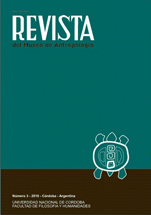Other anthropologies and other histories of the argentine anthropology
DOI:
https://doi.org/10.31048/1852.4826.v3.n1.5458Abstract
It's interesting that many people didn't know how to define what I was doing: Cortazar said it was NOT folklore, comrades who read in public the report on population, which was anything but NOT anthropology; Palavecino: that I first had to crawl before flying; some others that my things were a mixture of sociology, human geography, history; others that were bolder spoke of applied anthropology, etc. /.../ But I want to reiterate my detachment from being included as a member of the community of academic anthropologists. My decision was made at the time, well thought out and meditated: to try to do something that I didn't know very well what it was, but I did know that I didn't have to do what academics do (Bilbao 2003, personal communication).
Nevertheless, Santiago Bilbao had graduated with the first cohort of anthropological science graduates from the UBA in 1963. His paths took him from the comparsas of the porteño carnival to the works of the Chaco, the migrants from Santiago and the "worker-owners" of the Campo de Herrera cooperative in Tucumán, until he settled in Venezuela and collaborated with potato and banana producers, ending up writing about the Argentinean sections of two foreign anthropologists: Alfred Métraux and Roberto Lehmann-Nitsche. The decision of his "detachment" to be framed in some academic classification, very typical of a personality inexorably committed to social practice and fieldwork, which for him were synonyms, was one of the many options taken by anthropologists and other social scientists in the 1960s and 1970s. This option encloses, like everything he did, a quarry of senses that an anthropology of anthropology is able to exhume.
Downloads
Downloads
Published
Issue
Section
License
Those authors who have publications with this Journalaccept the following terms:
a. Authors will retain their copyrights and guarantee the journal the right of first publication of their work, which will be simultaneously subject to the Creative Commons Attribution License (Licencia de reconocimiento de Creative Commons) that allows third parties to share the work as long as its author and his first publication in this journal.
b. Authors may adopt other non-exclusive licensing agreements for the distribution of the version of the published work (eg, deposit it in an institutional electronic file or publish it in a monographic volume) provided that the initial publication in this journal is indicated.
c. Authors are allowed and recommended to disseminate their work on the Internet (eg in institutional telematic archives or on their website) before and during the submission process, which can lead to interesting exchanges and increase citations of the published work. (See The Effect of Open Access - El efecto del acceso abierto)












